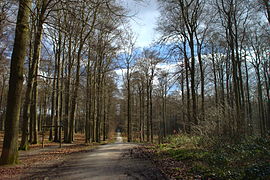Sonienwald
The Sonienwald or Sonian Forest ( Dutch Zoniënwoud , French Forêt de Soignes ) is a 4421 hectare forest on the south-eastern edge of Brussels in Belgium .
The forest extends over the territory of the Flemish municipalities of Sint-Genesius-Rode , Hoeilaart , Overijse and Tervuren , the municipalities of Uccle , Watermael-Boitsfort , Auderghem and Woluwe-Saint-Pierre in the Brussels-Capital Region , and the Walloon municipalities of La Hulpe and Waterloo . The forest thus extends over all three regions of Belgium . It is managed jointly by all three regions. The 347 hectares of the Kapucijnenbos (Capuchin Forest ) are part of the Royal Donation .
history
The Sonienwald is a remnant of the coal forest . In Roman times, the coal forest stretched from the banks of the Rhine and Moselle to the North Sea . The Sonienwald remained almost completely intact until the 15th century. Initially owned by the Counts of Leuven and later by the Dukes of Brabant . At the end of the 12th century they used the forest as a hunting ground. During this time religious communities settled in the forest. Names such as Ter Kameren , Groenendaal, Hertoginnedal, Rood Klooster and the Capuchin monastery became well known as centers of religious and cultural life. In the eventful 18th century, the forest was plundered by the population, who felled trees out of financial difficulties. Under the rule of the Austrian Habsburgs (1714–1795), beech trees were planted by the landscape architect Joachim Zinner. These still form the majestic beech cathedral today.
ecology
Due to its location in the middle of the settlement area, the flora and fauna of the Sonian Forest are under pressure. Various traffic routes such as the European route 411 , the Brussels - Namur railway line or the Ring 0 run through the middle of the forest and divide it into individual parts. This hinders animals in their behavior and limits their habitat . Various measures such as green bridges and wild fences are being used to counteract ecological fragmentation.
flora
The forest consists of 70 percent beech . Other tree species that occur are oak , chestnut , ash , alder and maple . Beeches over 200 years old are no exception. They date from the first plantings in the 18th century.
fauna
40 species of mammals live in the forest. The previously common species brown bear , wolf , red deer , badger , dormouse and the brown hare no longer occur today. Today deer and squirrels are common. 14 bat species are also found in the forest. The wild boar can be found again in the Sonien Forest in 2006 after an absence of more than 100 years.
World heritage
| Old beech forests and primeval beech forests of the Carpathian Mountains and other regions of Europe | |
|---|---|
|
UNESCO world heritage |
|
| National territory: |
|
| Type: | nature |
| Criteria : | (ix) |
| Reference No .: | 1133 |
| UNESCO region : | Europe and North America |
| History of enrollment | |
| Enrollment: | 2007 (session 31) |
| Extension: | 2011, 2017 |
In 2017 five areas in the Sonienwald were added to the UNESCO World Heritage List . With a multitude of old beech forests, parts of the Sonienwald belong to the entry Old beech forests and primeval beech forests of the Carpathians and other regions of Europe . The areas have a total area of 269 hectares. There is also a buffer zone of 4,651 hectares, which includes almost the entire Sonia forest.
Web links
swell
- ↑ Natuurgroepering Zoniënwoud vzw .: Natuurgroepering Zoniënwoud vzw., Who are? Natuurgroepering Zoniënwoud vzw., Accessed on August 31, 2017 .
- ↑ Manager - Zoniënwoud. Sonian Forest coordination team, accessed on August 31, 2017 .
- ↑ Back to the present - Zoniënwoud. Sonian Forest coordination team, accessed on August 31, 2017 .
- ↑ Counteracting ecological fragmentation - Zoniënwoud. Sonian Forest coordination team, accessed on August 31, 2017 .
- ↑ Special trees - Zoniënwoud. Sonian Forest coordination team, accessed on August 31, 2017 .
- ^ Mammals - Zoniënwoud. Sonian Forest coordination team, accessed on August 31, 2017 .
- ^ Ancient and Primeval Beech Forests of the Carpathians and Other Regions of Europe, Maps . accessed on August 31, 2017.









